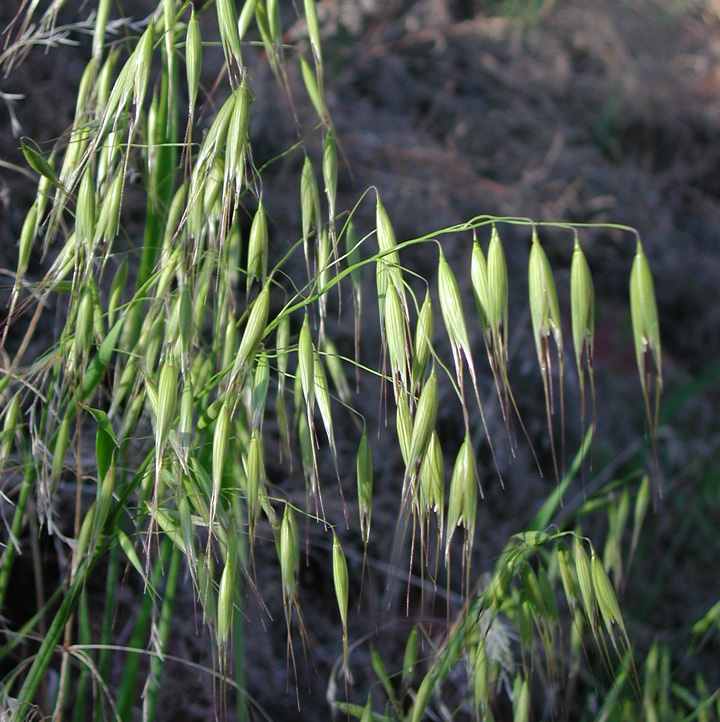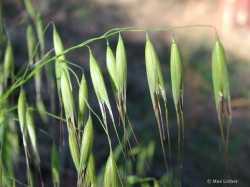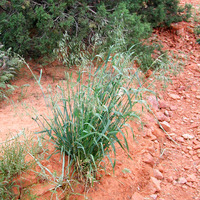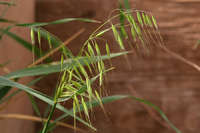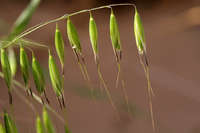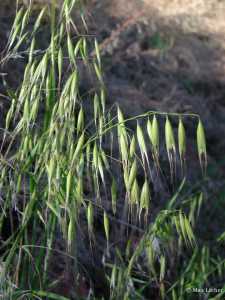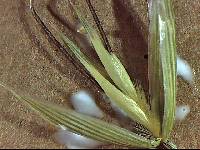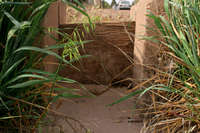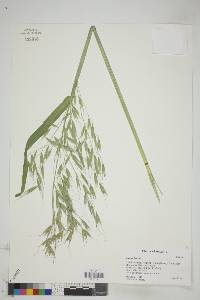|
|
|
|
Family: Poaceae
western oat, more...wild oat
[Avena fatua var. glabrata Peterm., moreAvena fatua var. vilis (Wallr.) Hausskn., Avena occidentalis Durieu] |
Plants annual. Culms 8-160 cm, prostrate to erect when young, becoming erect at maturity. Sheaths of the basal leaves with scattered hairs, distal sheaths glabrous; ligules 4-6 mm, acute; blades 10-45 cm long, 3-15 mm wide, scabridulous. Panicles 7-40 cm long, 5-20 cm wide, nodding. Spikelets 18-32 mm, with 2(3) florets; disarticulation beneath each floret; disarticulation scars round to ovate or triangular. Glumes subequal, 18-32 mm, 9-11-veined; calluses bearded, hairs to 1/4 the length of the lemmas; lemmas 14-22 mm, usually densely strigose below midlength, varying to sparsely strigose or glabrous, veins not extending beyond the apices, apices usually bifid, teeth 0.3-1.5 mm, awns 23-42 mm, arising in the middle 1/3 of the lemmas; lodicules without lobes on the wings; anthers about 3 mm. 2n = 42. Avena fatua is native to Europe and central Asia. It is known as a weed in most temperate regions of the world; in some parts of Canada and the United States it is considered a noxious weed. Avena fatua is sometimes confused with A. occidentalis, but differs in having shorter, wider spikelets, fewer florets, and a distal floret which does not have a heart-shaped disarticulation scar. Hybrids between A. fatua and A. sativa are common in plantings of cultivated oats. The hybrids resemble A. sativa, but differ in having the fatua-type lodicule; some also have a weak awn on the first lemma. They are easily confused with fatuoid forms of A. sativa. Stout annual to 10+ dm; ligules 2-6 mm; blades scabrous to somewhat pilose, 3-10(-15) mm wide; panicle 10-25+ cm, open, its branches horizontally spreading; spikelets ±nodding, (2)3-fld, the hirsute rachilla readily disarticulating; glumes prominently (7)9- or 11-veined, the first one 19-26+ mm, lanceolate, acuminate; lemmas 14-20+ mm, 5-or 7-veined, usually with brown hairs on the back, the 2 lower ones awned; awns (18-)28-45(-52) mm, stout, geniculate, twisted below, thin and tapering above, attached above the middle of the lemma; third lemma usually awnless; 2n=42. Native of Europe, frequently adventive or established as a weed of cult. ground or waste places, but not common in most of our range except at the nw. Gleason, Henry A. & Cronquist, Arthur J. 1991. Manual of vascular plants of northeastern United States and adjacent Canada. lxxv + 910 pp. ©The New York Botanical Garden. All rights reserved. Used by permission. FNA 2007, Gould 1980 Common Name: wild oat Duration: Annual Nativity: Non-Native Lifeform: Graminoid General: Large, erect tufted annual grass with smooth, thick but weak stems 30-120 cm tall. Vegetative: Sheath open, with collar margins sparsely villous; ligule membranous, 4-6 mm long, toothed with an obtuse to acute tip; blades thin and flat with sparsely villous margins, 5-12 mm wide, 10-30 cm long. Inflorescence: Panicle large with spreading and curving branches and pedicels; spikelets 2 or 3 flowered; glumes glabrous, 2-3 cm long; lemmas pubescent and rounded on back, firm, 2 cm long with a stout, twisted and geniculate awn that is 2-4 cm long; disarticulation beneath each floret. Ecology: Found in roadsides, fields, and waste place, below 7,500 ft (2286 m); flowers March-July. Distribution: Native to Europe and c Asia; naturalized in temperate regions throughout the world; found throughout n Amer. Notes: Tall annual grass with a large panicle of drooping spikelets, each spikelet has 2 or 3 long, bent awns. Total length of each spikelet is much larger than most grasses, at 2 cm without awns and ca. 5 cm including the awns. Distinguished from A. sativa by virtue of its much narrower blades and weaker stems. Ethnobotany: The seeds were parched, ground into flour, boiled, pounded, eaten dry, as mush, pinole, and stored for later use. Etymology: Avena is Latin for oats, while fatua means foolish, insipid, or worthless. Synonyms: Avena fatua var. glabrata, A. fatua var. vilis Editor: SBuckley 2010, AHazelton 2015 |
|
|
|


